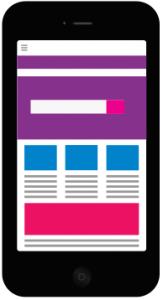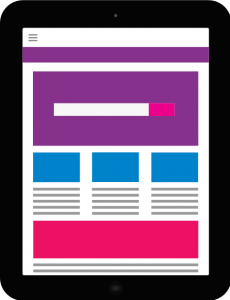
- Date: Jul 02, 2019
- Category:
Today, most of the internet users surf the internet using their mobile devices. According to stats, around 70% of web traffic in 2018 came from mobile devices. These numbers are no longer shocking as the popularity of mobile devices among users of all ages have increased manifold over the last few years. From accessing Facebook to searching for any service or checking emails, users prefer mobile over any other device as it is more convenient and flexible. Even patients are seen booking appointments and discussing their health conditions with doctors on different mobile apps.
As a result, mobile marketing has turned out to be an integral part of healthcare marketing today. Healthcare companies need to have an effective mobile marketing strategy to attract the customer base who use mobile devices more than desktop. A mobile optimized website, email template, and an app is what can ensure success for medical marketers in promoting their brand and spreading awareness.
However, there are specific to-do and not-to-do lists that marketers have to pay heed so that they can build and execute a strong mobile strategy. Here is the list in detail:
What to do?
Content Should Be Mobile-friendly
Mobile users are less patient, and they want information that can be viewed on their device on the go. Unlike desktop users, searches of mobile users are more specific. Also, as the mobile screen is smaller than the desktop, so while optimizing your website content, you need to keep that in mind. Usually, long headlines don’t work well on mobile as the display screen is small. Hence, you need to craft mobile content accordingly. It should be, and to the point, that is what mobile users prefer.

Make sure that your healthcare website content and even your call to action section is optimized, keeping in mind mobile users. If your medical practice site has content that patients and healthcare professionals can easily view and scroll through on their mobile device, they are more likely to stay for long and might be encouraged to respond.
Build Easy to Navigate Website
Poor navigation is one of the reasons why your healthcare prospects are leaving your practice website midway and not coming back. If you want your healthcare mobile strategy to work, then you need to build mobile websites that are easy and quick to navigate. A slight discomfort while surfing through your website can compel visitors to leave soon.

To ensure that your mobile site is navigation-friendly, then the first and the foremost thing to do is develop a responsive website design that makes navigation seamless and convenient for the customers. You can even do A/B testing before making your site live so as to check how it is performing.
Develop Easy to Use Website
In 2019, make sure that you include one of the key elements of mobile marketing strategy, which is focusing on how to make your website easy to use. Think from the customers perspective, and then you can easily understand where your website is not standing up to customer’s expectations. For instance, if the loading time of your medical website is slow, then the visitor will likely exit soon, which is something not good for your business.
Also, too many dropdown menu isn’t something that will go well with your mobile version of the website. Moreover, autoplay videos that abruptly starts in the middle of something are really irritating for the user. So, ensuring these things are in place, and the user isn’t force fed anything on your site can help you win big with your mobile strategy.

Add Videos to Your Web Pages
Mobile users consume more videos than texts on their mobile devices. Hence, creating more videos and adding them to your medical site pages can help the growing population of mobile users. Videos can be on product demonstration, user guides or tutorials, customer testimonials, etc. that encourages increased viewership and in return, boosts conversion rate. Even brand introduction videos or video message from the hospital CEO or company healthcare executive can strengthen your mobile strategy.
Use QR Codes

If you have a tonne of data that you want to make available to users via mobile browsers, then you can create QR codes that are fast and generates a quick response. QR codes or elaborately known as Quick Response code is a type of two-dimensional bar code that consists of information about any particular item to which it may be attached. You can assign a QR code to your website to make the digital transmission of data from your website to the users fast.
Local Search Optimization is a Must
Mobile users behave differently as compared to desktop users, and this fact is quite evident in terms of local search volume that comes mostly from mobile devices. Hence, it becomes essential for healthcare brands to optimize their mobile website for local searches. As most local searches come from mobile users, so adding Google My Business to your healthcare site can help improve your search engine visibility.
What not to do?
Sending Same Messages to All Mobile Devices
By all mobile devices, we mean different operating systems (OS) like Android, iPhone, Blackberry, and so. Hence, the functioning and settings of one OS may not be similar to the other. But if you send the same message to devices having a different OS, then you are doing completely wrong. This is because although your message is the same, but the device it is sent to may have different operating systems. As a result, the display of information may vary. What may appear clear on an iPhone may not appear the same on an Android phone. So, do not send the same information to every device. Gather information on what your healthcare customers are using and accordingly target specific device type with relevant messages that are displayed correctly.
Relying on Same Channel for Communication
There are multiple channels to communicate with your mobile users. Mobile devices are used for reading and sending emails, networking on social media sites, and for using various apps. So, don’t focus only on one communication channel to engage and connect with your healthcare customers. Make the most use of all the possible channels that mobile users may have access to on their devices. For instance, you can send emails to market your healthcare services to mobile users or can even send push notifications to notify them of exclusive deals and offers.
Having a Complicated Checkout Page
Cart abandonment is one of the many challenges that B2B marketers and even B2C companies face. Just when the buyer is going to click on pay now, due to some or the other reason they leave the page. It may be because of high shipping charges or a sudden change of mind. However, when cart abandonment happens on a mobile device, it may be because of reasons like slow page loading speed, lack of preferred payment mode, complicated checkout page, and so. Hence, if you want to tackle these issues, then you must try building a mobile-friendly checkout page for mobile users.
Final Note
Mobile marketing is not rocket science that requires exceptional skills. With the correct understanding of what your healthcare audience wants, you can quickly build your own strategy. Remember that mobile users are not like desktop users. They have different approach and preferences. Most of the mobile users are millennials who want fast and efficient experience while surfing through a mobile healthcare site. Hence, following these do’s and don’ts can help your future marketing plans targeting mobile users.




